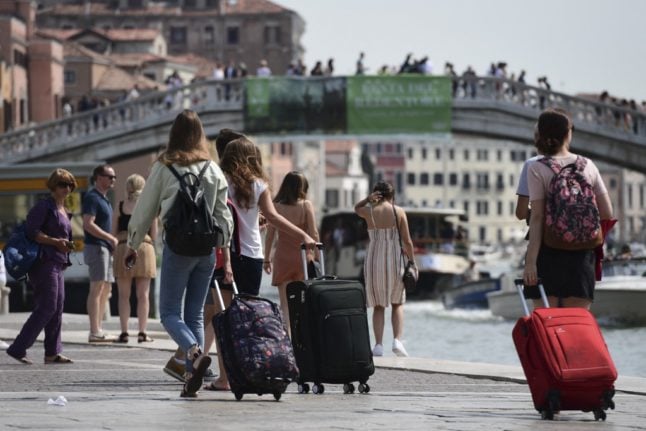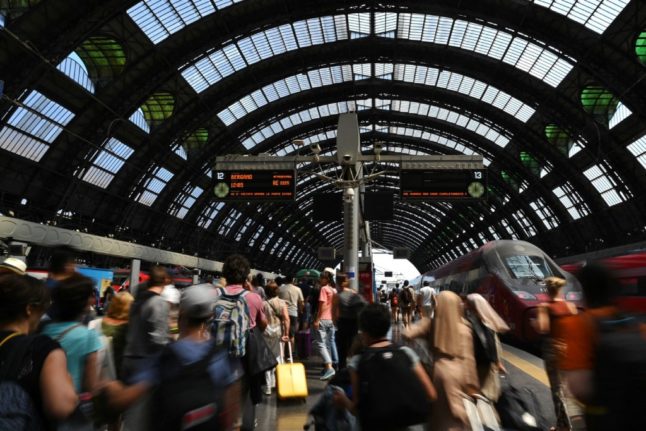Covid-19 closures and restrictions have battered the Italian tourism sector. With tourism accounting for a large chunk of the Italian economy, Italy suffered a particularly hard shock when the pandemic hit in 2020.
In 2019, before the pandemic hit, tourism accounted for about 14 percent of Italian GDP and nine percent of all jobs in the country.
READ ALSO: What you need to know about travel to Italy this spring
Some 96 million international tourists visited the country that year, and domestic and foreign tourism meant Italy was raking in an estimated €236 billion in direct and indirect contributions to GDP.
So high was the number of tourists arriving in Italy, in fact, that many major destinations were voicing concerns about overtourism and putting measures in place to manage the extreme overcrowding becoming a regular sight at peak times for travel.
The number of – and revenue from – international tourists was only expected to keep growing, mainly due to the rising number of arrivals from China, tourism industry groups said in 2019.
All that, of course, came to an abrupt halt in early 2020.

Over the course of that one year, the country lost a staggering €120.6 billion as a result of travel and tourism restrictions – equating to a 51 percent decrease in tourism’s contribution to Italy’s gross domestic product (GDP) and leaving an estimated 337,000 people unemployed.
Despite Italy easing health measures somewhat over the past two summers, travel has remained heavily restricted for many, and the sector has continued to struggle on.
Tourism recovered slightly in 2021, but visitor numbers stayed far below normal as international travel restrictions remained in place for much of the year.
But spring 2022 brings more optimism, as the Italian government plans to drop almost all Covid restrictions by mid-June in a bid to lure back tourists and boost the economy.
“The summer will go very well,” Italy’s tourism minister Massimo Garavaglia predicted in an interview with the Corriere della Sera news daily on Monday.
“As far as Covid is concerned, from May Italy is playing by same rules as other countries and is on a level playing field, and our country will go all out: there is so much interest in Italy and we must organise ourselves to capture it”.
READ ALSO: What to expect if you’re returning to Italy this Easter
Statistics appear to show however that while Italy’s tourism industry is on the path to recovery, a return to full health is still some distance away.
The number of domestic and international tourists in Italy is set to rise by 43 percent compared to 2021, according to a new survey from the market research institute Demoskopika.
That means 92 million people – both Italians and foreigners – are expected to take trips over the course of 2022.
But this is still 29.6 percent fewer than the number in 2019.
The study said tourism expenditure in Italy is set to amount to around 26 billion euros this year, up 11.8 percent on 2021.
As for domestic travel, 51 percent of Italians – around 30 million people – are planning a holiday in the next few months, 90 percent of whom will remain in Italy.
However, Demoskopika predicted that Italy’s travel sector will need to undergo some “profound” changes before it can recover fully.
“Tourism as we have known it until some time ago is probably in hibernation,” stated president of Demoskopika Raffaele Rio in a press release.
OPINION: Italy must update its image if it wants a new kind of tourism

“The system needs to undergo a profound transformation in terms of sustainability, to respond adequately to the new purchasing behavior of tourists generated by the pandemic emergency,” he said.
“Individuals, at the time of choosing the holiday, pay more and more attention to respect for local communities, to unique experiences immersed in the local culture, to avoiding the most popular destinations.”
Revenue from domestic tourism has meanwhile become increasingly important in Italy amid the pandemic.
This Easter, around 14 million Italians will be travelling within the country, with 25 percent taking an extra day off around April 25th (Italy’s ‘Liberation Day’, and a public holiday) to go on holiday, according to Italian hotel association Federalberghi.
The coast remains (only just) the most popular destination for Italians planning to travel at Easter, with 28.9 percent headed to seaside resorts, according to the Federalberghi survey.
Meanwhile, 28.7 percent plan to visit Italian cities of art and culture, and 16.4 percent to the mountains.
READ ALSO:
- Six Italian walking holiday destinations that are perfect for spring
- MAP: Here’s where to find Italy’s 400 best beaches
- Five crowd-free alternatives to Italy’s tourist hotspots
Come summer, Demoskopika’s survey estimates that more than half (57 percent) of people in Italy will go to the beach. Of the 10 percent of Italians planning on travelling abroad, only 3 percent will leave the continent, with the remaining 7 percent staying within Europe’s borders.
But for many people, things are far from ‘back to normal’ this year.
Travel will not be on the cards for 13 percent of Italian families surveyed due to a worsening of their financial situation amid the pandemic and the rising cost of living.
The war in Ukraine was also cited as a major factor in the decision not to travel this year by ten percent of Italians, while another eight percent said they would not be travelling due to ongoing concern about Covid and new variants.
Demoskopika also estimated that the absence of some 300,000 Ukrainian and Russian tourists this year will cost Italy almost €180 million in lost tourism revenue.



 Please whitelist us to continue reading.
Please whitelist us to continue reading.
Member comments